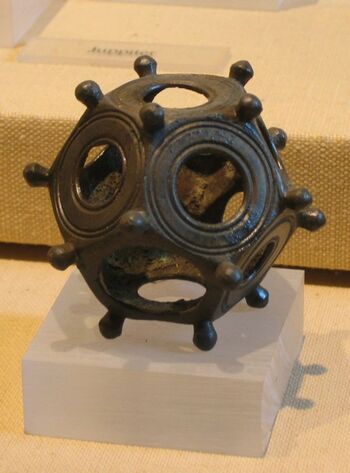Roman dodecahedron (nonfiction)
A Roman dodecahedron is a small hollow object made of bronze or stone, with a dodecahedral shape: twelve flat pentagonal faces, each face having a circular hole of varying diameter in the middle, the holes connecting to the hollow center. Roman dodecahedra date from the 2nd or 3rd centuries CE.
About a hundred of these dodecahedra have been found from Wales to Hungary and Spain and to the east of Italy, with most found in Germany and France. Ranging from 4 to 11 centimetres (1.6 to 4.3 in) in size, they also vary in terms of textures. Most are made of bronze but some are made of stone.
No mention of them has been found in contemporary accounts or pictures of the time.
Speculated uses include candlestick holders (wax was found inside two examples); dice; survey instruments for estimating distances to (or sizes of) distant objects; devices for determining the optimal sowing date for winter grain; gauges to calibrate water pipes or army standard bases.
Use as a measuring instrument of any kind seems improbable since the dodacahedrons were not standardised and come in many sizes and arrangements of their openings.
It has also been suggested that they may have been religious artifacts, or fortune telling devices.
Several dodecahedra were found in coin hoards, providing evidence that their owners considered them valuable objects.
In the News
Polyhedral dice celebrate the memeory of their Roman dodecahedron ancestors.
Fiction cross-reference
Nonfiction cross-reference
External links:
- Roman dodecahedron @ Wikipedia
